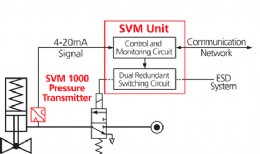Smart Valve Monitoring delivers networked solution for increased partial stroke test functionality

The Rotork SVM field unit is incorporated on the valve actuator control panel for hazardous area applications.

Typical Rotork SVM installation schematic
This is made possible by the ability of the SVM to be integrated into an existing Ethernet and fibre optic infrastructure, enabling over one hundred monitored valve actuators on wellheads at numerous locations to be networked over distances of ten kilometres or more.
The SVM field control units on this project are attached to the ESD circuits for shut off valves installed in sets of two and four on more than fifty wellheads. Analysis is performed on the SVM server computer in the centralised control room. Communication between the wellhead sites and the computer is fully integrated within the operator’s existing network infrastructure. The SVM field units are incorporated into the Ethernet network that links other equipment and instrumentation at each wellhead site. A fibre optic link is then used to transmit the data to intermediate engineering and control stations at two manifold sites. From these sites, fibre optic links are again used to transmit data from all the wellheads to the centralised control room.
Partial stroke testing (PST) is a function used in a safety instrumented system (SIS) to enable the operator to identify possible failure modes on a shutdown or emergency shutdown (ESD) valve without the need to completely close the valve and hence disrupt the process. Partial stroke testing is an accepted hydrocarbon industry standard technique that is quantified in detail by regulatory bodies such as the IEC and ISA.
The partial valve stroke prevents unexpected failure on demand of the safety function and demonstrates that certain potential problems that would otherwise go undetected, such as spring fractures in the spring chamber of the pneumatic actuator, are not present. Consequently, the interval for testing for these otherwise undetected errors can be extended.
The Rotork Smart Valve Monitor incorporates several features that are not available from other systems, as well as providing detailed diagnostic data that allows the operator to plan for strategic preventative maintenance. The key to the SVM’s reliable performance is its separation from the valve’s control system. This enables the operator to design the control system exactly to suit the routine and safety requirements without having to compromise for the testing programme.
The SVM system is powered by the control signal to the actuator’s solenoid valve. The monitoring function is then provided by a pressure transmitter located between the solenoid valve and actuator which records the instrument pressure changes whilst the valve is moving. Any change in the valve performance is detected and identified by a change in the pressure wave exiting the actuator. The simple, self-contained design of the SVM enables it to be used with the most complex control mechanisms and makes it impossible for the SVM to prevent the valve from closing on demand.
Analysis of the 4-20mA signal from the pressure transmitter during the partial stroke test is performed using SVM software to confirm the correct functioning of the valve or identify a fault. To achieve this, the output pressure curve of the transmitter is compared with the pressure signature of the actuator, obtained during commissioning. Identified faults can include valve obstructed, damaged actuator cylinder, seized valve or failsafe spring failure, stem shear or disconnected valve, stiff valve, increased breakout torque, damaged valve seat, internal cylinder corrosion, exhaust restriction and sticking solenoid valve. The SVM always tests every final element component of the shutdown system and is therefore capable of detecting all the failure modes of the valve, actuator and controls that are possible during a partial stroke test. It is designed to ensure that operators obtain the maximum safety performance from their systems whilst running their plants at maximum efficiency.
The benefits of using the SVM are therefore not limited to simply reducing the probability of valve failure on demand. Gains can also be made in the capital cost and the production performance of a plant. For example, the requirement for costly redundant valves can be reduced or eliminated. Production performance can be enhanced by extending the periods between compulsory plant shutdowns and predicting potential valve failures, enabling the pre-ordering of spare parts and identification of maintenance priorities.
Rotork Fluid Systems
Tel: +44 (0) 1225 733200
www.rotork.com

| Telephone: | 0113 256 7922 |
| Email: | mail@rotork.com |
| Website: | www.rotork.com |
| More information on the Rotork UK BVAA Member Directory Page |
Search related valve / actuator articles: Rotork UKIssue 24Remote Control Systems







-web.jpg)





